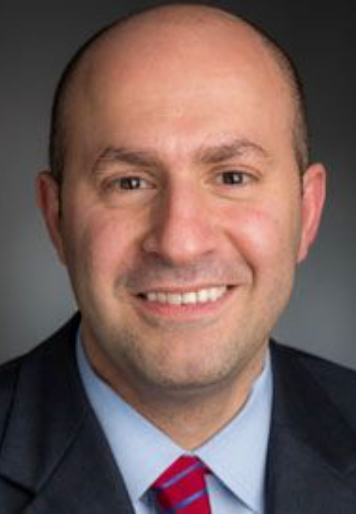Publication
Article
Oncology Live®
Investigators Highlight Top Advances at ESMO 2022
Data presented at the ESMO Congress 2022 highlighted advances across treatment modalities, including landmark data for trials in melanoma, breast cancer, and lung cancer, as well as early data that made headlines in a subgroup of patients with colon cancer.
Lung, Head and Neck Cancers
Melissa Johnson, MD

Sotorasib versus docetaxel for previously treated non-small cell lung cancer with KRAS G12C mutation: CodeBreaK 200 phase III study (Abstract LBA 10)
The KRAS G12C inhibitor sotorasib (Lumakras) doubled the rate of progression-free survival (PFS) at 12 months and reduced the risk of progression or death by 34% compared with docetaxel for patients with previously treated non–small cell lung cancer (NSCLC) with KRAS G12C mutations, according to findings from the phase 3 CodeBreaK 200 trial (NCT04303780).
At a median follow-up of 17.7 months, the 12-month PFS rate was 24.8% with sotorasib compared with 10.1% with docetaxel. Median PFS was 5.6 months (95% CI, 4.3-7.8) with sotorasib vs 4.5 months (95% CI, 3.0-5.7) with docetaxel (HR, 0.66; 95% CI, 0.51-0.86; P = .002). There were fewer grade 3 or greater treatment-related adverse effects with the KRAS G12C inhibitor compared with chemotherapy (33.1% vs 40.4%, respectively). Additionally, serious adverse events were less common with sotorasib vs docetaxel (10.7% vs 22.5%).
The median overall survival was 10.6 months (95% CI, 8.9-14.0) with sotorasib compared with 11.3 months (95% CI, 9.0-14.9) with docetaxel (HR, 1.01; 95% CI, 0.77-1.33; P = .53). Thirty-six percent of patients in the sotorasib arm received a subsequent therapy at crossover compared with 42% in the docetaxel arm. A subsequent KRAS G12C inhibitor was received by 34% of patients in the docetaxel arm. The most common treatment at crossover for those in the sotorasib arm was chemotherapy (21%).
For the study, patients were randomly assigned to receive either oral sotorasib at 960 mg per day (n = 171) or intravenous (IV) docetaxel at 75 mg/m2 every 3 weeks (n = 174). All patients had received prior platinum-based chemotherapy and a checkpoint inhibitor either concurrently or sequentially.
The objective response rate with sotorasib was 28.1% (95% CI, 21.5%-35.4%) compared with 13.2% (95% CI, 8.6%-19.2%) with docetaxel (P <.001). When also considering patients with stable disease, the overall disease control rate was 82.5% for sotorasib compared with 60.3% with docetaxel. Any degree of tumor shrinkage was seen in 80.4% of patients treated with sotorasib compared with 62.8% of those treated with docetaxel.
"In my opinion, this supports sotorasib as a new second-line standard for patients with KRAS G12C–mutated NSCLC. We look at [CodeBreaK 200] as the first step. There are more studies ongoing adding other drugs to it. It is well tolerated, so it will pair nicely with other drugs inhibiting MAP kinase, EGFR, and even PD-L1.”
Primary results of the phase 3 KEYNOTE-412 study: Pembrolizumab plus chemoradiation therapy (CRT) vs placebo plus CRT for locally advanced head and neck squamous cell carcinoma (Abstract LBA 5)
Nabil F. Saba, MD, FACP

Pembrolizumab (Keytruda) plus chemoradiation failed to demonstrate a statistically significant improvement in event-free survival (EFS) vs chemoradiation alone in patients with locally advanced head and neck squamous cell carcinoma, according to findings from the phase 3 KEYNOTE-412 trial (NCT03040999).
The results showed that median EFS was not reached (NR; 95% CI, 44.7-NR) with pembrolizumab plus chemoradiation vs 46.6 months (95% CI, 27.5-NR) with chemoradiation alone, failing to meet the superiority threshold of a 1-sided alpha of 0.0242 (HR, 0.83; 95% CI, 0.68-1.03; P = .0429). The 24-month EFS rate was 63.2% with pembrolizumab/chemoradiation vs 56.2% with chemoradiation alone; the 36-month EFS rates were 57.4% and 52.1%, respectively.
The median overall survival (OS) was NR in either arm (HR, 0.90; 95% CI, 0.71-1.15). The 24-month OS rates in the pembrolizumab/ chemoradiation and chemoradiation-alone arms, respectively, were 77.9% and 76.8%; the 36-month OS rates were 71.9% and 70.1%.
In a post hoc analysis of EFS and OS in patients with a PD-L1 CPS of at least 20, the addition of pembrolizumab to chemoradiation appeared to result in greater benefit compared with chemoradiation alone. Here the median EFS was NR in either arm but demonstrated a 24-month EFS rate of 71.2% with pembrolizumab/chemoradiation vs 62.6% with chemoradiation alone; the 36-month EFS rates were 66.7% and 57.2%, respectively (HR, 0.73; 95% CI, 0.49-1.06). The median OS was also NR in either arm, but indicated a 24-month OS rate of 83.3% with pembrolizumab/chemoradiation vs 79.9% with chemoradiation alone; the 36-month OS rates were 79.1% and 73.0%, respectively (HR, 0.67; 95% CI, 0.43-1.04).
"In this study, pembrolizumab given as a lead-in dose, concomitantly with chemoradiotherapy and then adjuvantly for 1 year, failed to deliver a statistically significant improvement in EFS as a primary end point when compared with placebo. Even though there was a trend in favor of the pembrolizumab arm in the intention-to-treat and PD-L1–positive populations, the current study [data] cannot be interpreted as an indication for were 0.41 (95% CI, 0.23-0.69), 0.34 (95% CI, 0.230.52), and 0.20 (95% CI, 0.14-0.29), respectively. This update was good, as we try to use of anti–PD-1 therapy in combination with chemoradiotherapy in any patient group. Indeed, in light of the recent presentations of negative findings from the JAVELIN Head and Neck 100 [NCT02952586], REACH [NCT02999087], and PembroRad [NCT02707588] studies, these data should signal the need for a change in thinking in how to design optimal combination regimens. Focus is now likely to shift to neoadjuvant and true adjuvant therapy approaches.”
Osimertinib as adjuvant therapy in patients (pts) with resected EGFR-mutated (EGFRm) stage IB-IIIA non–small cell lung cancer (NSCLC): Updated results from ADAURA (Abstract LBA 47)
Solange Peters, MD

Adjuvant osimertinib (Tagrisso) resulted in a 77% reduction in the risk of disease recurrence or death in patients with EGFR-mutated, stage II to IIIA non–small cell lung cancer (NSCLC), with a disease-free survival (DFS) improvement observed irrespective of prior adjuvant chemotherapy or disease stage, according to updated findings from the phase 3 ADAURA trial (NCT02511106).
At a median follow-up of 44.2 months (range, 0-67) with osimertinib (n = 233) and 19.6 months (range, 0-70) with placebo (n = 237), the median DFS was 65.8 months (95% CI, 54.4-not calculable [NC]) vs 21.9 months (95% CI, 16.6-27.5), respectively, in the population of patients with stage II/ IIIA disease (HR, 0.23; 95% CI, 0.18-0.30).
In the overall population, osimertinib (n = 339) resulted in a median DFS of 65.8 months (95% CI, 61.7-NC) vs 28.1 months (95% CI, 22.1-35.0) with placebo (n = 343), translating to a 73% reduction in the risk of disease recurrence or death (HR, 0.27; 95% CI, 0.21-0.34). In this group, the median follow-up for those who received osimertinib was 44.2 months (range, 0-69) and 27.7 months (range, 0-70) for those given placebo.
Notably, the DFS benefit provided by osimertinib over placebo was observed across all predefined subgroups. In those who received prior adjuvant chemotherapy (n = 410), the HR for DFS was 0.29 (95% CI, 0.21-0.39); the HR was 0.36 (95% CI, 0.24-0.55) in those who did not (n = 272). The HRs for those with stage IB (n = 212), stage II (n = 236), and stage IIIA (n = 234) disease, per criteria according to the AJCC Cancer Staging Manual, 7th edition (American Joint Committee on Cancer/Union for International Cancer Control), were 0.41 (95% CI, 0.23-0.69), 0.34 (95% CI, 0.230.52), and 0.20 (95% CI, 0.14-0.29), respectively.
"This update was good, as we try to anticipate what the long-term observation of the Kaplan-Meier curves will have us conclude. The DFS curve is the anticipated [marker] and simulation of the survival. The more [follow-up we have], the more we see the separation of the curves remain and an overall survival benefit is anticipated.
The [presentation] confirms the magnitude of osimertinib vs placebo across stages. Discussants noted that [patients with] stage II and stage III [disease] start to benefit less than the stage I, so the patients with less risk of relapsing look like they are starting to benefit more. This may be the topic of a dedicated trial, but it looks like even when the lymph nodes are not affected by the disease, osimertinib might change the DFS and maybe the survival. It is quite interesting to see how much these data confirm the role of osimertinib in the adjuvant setting.
The challenge is more the biomarker assessment than the interpretation of the data. Does this mean we are just going to use a pCR for EGFR or are we going to an NGS 50 to 400 gene panel? At the time being we are trying to advocate that this trial will be continues across biomarkers to assess the same panel of genes you in this setting that you would do in the metastatic setting."
Trastuzumab deruxtecan (T-DXd) in patients (pts) with HER2-mutant metastatic non–small cell lung cancer (NSCLC): Interim results from the phase 2 DESTINY-Lung02 trial (Abstract LBA 55)
The clinical benefit and tolerable safety profile of fam-trastuzumab deruxtecan-nxki (Enhertu) was maintained at 5.4 kg/mg vs 6.4 kg/mg in patients with HER2-mutated non–small cell lung cancer (NSCLC), confirming the benefit-risk ratio of the FDA-approved dose, according to findings from an interim analysis of the DESTINY-Lung02 trial (NCT04644237).
The confirmed overall response rate in the prespecified early cohort (PEC) of the study was 53.8% (95% CI, 39.5%-67.8%) at the lower dose level (n = 52) and 42.9% (95% CI, 24.5%-62.8%) at the higher dose level (n = 28). The lower dose also showed superior safety and tolerability, including a lower rate of interstitial lung disease (ILD).
"Antibody-drug conjugates have 2 very important opportunities. First, if they are really targeted to a specific oncogene or molecular alteration of the tumor—such as HER2, which is dependent mainly on mutations in the exon 20 insertion in lung cancer, it’s a niche, something that is very well defined molecularly—there is a potential here to move them to the frontline. We need to use them instead of chemotherapy, even as monotherapy. I hope that this strategy will move frontline. Trastuzumab deruxtecan has also been examined in HER2 expressing [lung cancer], and there the response rate was not 50% it was 36%. This might not be enough to go frontline, but can we replace a toxic agent such as platinum or platinum-based chemotherapy, can we combine it with an anti–PD-L1/CTLA-4? When you are in this less actionable [arena] you might need to combine it.”
CANOPY-A: Phase III study of canakinumab (CAN) as adjuvant therapy in patients (pts) with completely resected non–small cell lung cancer (NSCLC) (Abstract LBA 49)
Edward B. Garon, MD

Patients with completely resected non–small cell lung cancer (NSCLC) did not derive a significant benefit with adjuvant canakinumab vs placebo, according to data from the phase 3 CANOPY-A trial (NCT03447769). Disease-free survival (DFS) was 35.0 months vs 29.7 months, respectively (HR, 0.94; 95% CI, 0.78-1.14; one-sided P = .258), missing the primary end point of the trial.
Further, a subgroup analysis of demographics, baseline disease characteristics and biomarkers of interest, showed there were no meaningful differences in DFS.
OS was not formally tested because DFS did not prove to be statistically significant; however, the data showed an OS HR of 0.722 (95% CI, 0.4821.081). The lung cancer–specific survival was similar between the experimental and control arms, with an HR of 0.900 (95% CI, 0.534-1.517).
"The role of inflammation in lung cancer has been long studied, but to date, it has not been effectively therapeutically harnessed. Canakinumab is a high-affinity antibody directed against IL-1β, a key mediator of inflammation.
Evaluation of biomarker data from the entire CANOPY program, which in addition includes a neoadjuvant study as well as 2 studies in advanced disease—1 combined with chemoimmunotherapy in a frontline setting and 1 combined with chemotherapy in the second-line setting—will continue to be evaluated to try and further elucidate the role of IL-1β in NSCLC.”
Gyn Cancers
Phase III EMPOWER-Cervical 1/GOG-3016/ ENGOT-cx9 trial of cemiplimab in recurrent or metastatic (R/M) cervical cancer: long-term survival analysis (Abstract 519MO)
Ursula A. Matulonis, MD

Cemiplimab (Libtayo) maintained an overall survival (OS) benefit vs chemotherapy as a second-line treatment for patients with recurrent or metastatic cervical cancer who received prior platinum-based chemotherapy, according to data from the long-term survival analysis of the phase 3 EMPOWER-Cervical 1 trial (NCT03257267).
In this study, investigators analyzed data from 608 patients with recurrent or metastatic cervical cancer after progression on first-line platinum-based chemotherapy. Patients were randomly assigned to receive either 350 mg of cemiplimab intravenously once every 3 weeks (n = 304) or investigator’s choice of single-agent chemotherapy (n = 304).
Compared with chemotherapy, treatment with cemiplimab significantly improved OS (11.7 months vs 8.5 months; HR, 0.656; 95% CI, 0.545-0.790; P < .00001). Cemiplimab reduced the risk of death by 34% in the overall population.
The effect was seen in patients with squamous cell carcinoma (10.9 months vs 8.8 months; HR, 0.69; 95% CI, 0.56-0.85; P = .00023), whose risk for death was reduced by 31%. In patients with adenosquamous carcinoma, cemiplimab treatment reduced the risk of death by 45%, thus increasing OS compared with chemotherapy (13.5 months vs 7.0 months; HR, 0.545; 95% CI, 0.365-0.814).
The median OS for patients in the PD-L1–positive group taking cemiplimab was 12.1 months vs 7.7 months for those who were PD-L1 positive and assigned chemotherapy (HR, 0.61; 95% CI, 0.45-0.83). For patients with PD-L1–negative status, the median OS with cemiplimab was 10.8 months compared with 7.0 months for those taking placebo, respectively (HR, 0.65; 95% CI, 0.43-0.98).
"[EMPOWER-Cervical1 data] showed that cemiplimab vs [physician] choice chemotherapy in the first recurrent space, had a really convincing improvement in OS. That benefit was seen not just in PD-L1 positive advanced [disease], but also in [those with] PD-L1 negative–disease. That wasn’t the case in the original New England Journal of Medicine paper, but we are seeing that now in the presentation with longer follow-up. Pembrolizumab is approved...in the newly diagnosed, advanced setting and cemiplimab [confirms benefit] of to the upfront immunotherapy for advanced disease.”
Overall survival (OS) at 7-year (y) follow-up (f/u) in patients (pts) with newly diagnosed advanced ovarian cancer (OC) and a BRCA mutation (BRCAm) who received maintenance olaparib in the SOLO1/ GOG-3004 trial (Abstract 517O)
Paul A. DiSilvestro, MD

Two years of olaparib (Lynparza) maintenance therapy elicited a long-term overall survival (OS) benefit vs placebo in patients with newly diagnosed, advanced ovarian cancer harboring a BRCA mutation, according to 7-year follow-up findings from the phase 3 SOLO1/GOG-3004 trial (NCT01844986).
As of the data cutoff, the median OS was not reached with olaparib treatment vs 75.2 months with placebo treatment (HR, 0.55; 95% CI, 0.400.76; P = .0004). The 7-year OS rates were 67.0% in the olaparib arm and 46.5% in the placebo arm. The median duration of follow-up in the olaparib and placebo arms were 88.9 months (range, 85.7-93.6) and 87.4 months (range, 84.391.7), respectively.
In total, 45.3% of patients in the olaparib arm and 20.6% in the placebo arm still had not received a first subsequent treatment, while 44.3% of patients given placebo received a PARP inhibitor in a subsequent line of therapy vs 14.6% of patients in the olaparib group.
The time to first subsequent therapy or death also was substantially delayed with olaparib, compared with placebo (median, 64.0 months vs 15.1 months; HR 0.37; 95% CI, 0.28-0.48). This benefit extended beyond first subsequent therapy into the time to second subsequent therapy or death (TSST) (93.2 months vs 40.7 months; HR 0.50; 95% CI, 0.37-0.67).
"These results support the use of maintenance olaparib to achieve long-term remission in women with newly diagnosed advanced ovarian cancer and a BRCA mutation. The potential for cure may also be enhanced. The OS benefit was seen despite over 40% of patients in the placebo group receiving subsequent PARP inhibitor therapy.
Ten-year survival in women with newly diagnosed advanced epithelial ovarian cancer is 17%. Relapsed advanced ovarian cancer is typically incurable, highlighting the need for effective firstline therapies that delay relapse, prolong survival, and enhance the potential for cure. Seven years of follow-up is a clinically relevant time point for survivorship, and the longest follow-up for any PARP inhibitor in newly diagnosed advanced ovarian cancer. These 7-year results provide further confirmation that the benefit of maintenance olaparib extends well beyond its 2-year treatment cap.”
Melanoma
Neoadjuvant versus adjuvant pembrolizumab for resected stage III-IV melanoma (SWOG S1801) (Abstract LBA 6)
Sapna Patel, MD

Compared with adjuvant pembrolizumab (Keytruda) alone, the addition of neoadjuvant pembrolizumab significantly improved eventfree survival (EFS) outcomes for patients with stage III-IV melanoma with an HR of 0.58 (95% CI, 0.39-0.87; P = .004), according to data from the phase 2 SWOG S1801 trial (NCT03698019).
The landmark 2-year EFS rate was 72% in the neoadjuvant arm (n = 159) compared with 49% in the adjuvant arm (n = 154). Tumor-related events—including disease progression, adjuvant therapy delays, and melanoma recurrence— occurred in 38 patients in the neoadjuvant arm and 67 patients in the adjuvant arm.
Twelve patients had disease progression that precluded surgery and 10 patients had residual disease or developed a metastasis prior to adjuvant therapy in the neoadjuvant arm. In comparison, 17 patients in the adjuvant arm experienced residual disease or developed metastasis prior to starting therapy.
Pembrolizumab in the neoadjuvant arm also improved EFS in all key subgroups in comparison with the adjuvant group. In particular, patients who were 66 years old or older had an HR of 0.4 (95% CI, 0.21-0.74), male patients had an HR of 0.48 (95% CI, 0.29-0.8), patients with stage IIIIC disease had an HR of 0.4 (95% CI, 0.22-0.75), and patients with BRAF-mutated disease had an HR of 0.44 (95% CI, 0.21-0.91).
Overall survival was also looked at in the study, but data were not mature at the time of presentation with only 36 deaths reported on the trial (HR, 0.63; 95% CI, 0.32-1.24; P = .18).
"Events occurring during the surgical period occurred in 21 participants in the adjuvant arm, most occurring at a post-operative tumor assessment radiology scan.
I think it’s hard to argue with the event-free survival that you’re seeing, but we do see that there are some patients who get neoadjuvant therapy and adjuvant therapy who recur quite early. On both [arms of the study], there was a percentage of patients who actually recurred prior to the initiation of adjuvant therapy. So we do need to consider upfront therapy for resectable patients and then also consider for patients in whom the therapy is not working what are our alternative strategies or markers for that resistance.
Future directions for this trial include completing [the evaluation of] pathologic response outcomes. We’ve centralized the pathologic evaluation of the tumors, so that should be forthcoming, as well as many translational biomarkers to really confirm the hypothesis that neoadjuvant therapy expanded a larger number of T cells than the adjuvant approach. In the future neoadjuvant studies can investigate de-escalation of surgery, de-escalation of adjuvant therapy regimens, duration of treatment, and various other aspects.
[The trial] also proves that these types of studies can be done across the US, including at community hospitals; about 50% of the sites that are enrolled in S1801 were community oncology practices and not just the academic centers. That’s really important when you think about these multidisciplinary studies that involve surgical oncology and medical oncology. This highlights the ability to do that across the United States.”
Neoadjuvant cemiplimab in patients (pts) with stage II–IV (M0) cutaneous squamous cell carcinoma (CSCC): Primary analysis of a phase II study (Abstract 789O)
Neil D. Gross, MD

Cemiplimab (Libtayo) produced pathologic complete responses (pCRs) as a neoadjuvant treatment in more than half of patients with resectable, stage II to IV cutaneous squamous cell carcinoma (CSCC), according to a primary analysis of a phase 2 trial (NCT04154943).
In total, 63.3% of patients (95% CI, 51.7%73.9%) experienced near or complete disappearance of their tumors when treated with the anti–PD-1 monotherapy, representing the highest response rates to this type of therapy in solid tumors.
Investigators observed a pCR in 40 patients (50.6%; 95% CI, 39.1%-62.1%) and a pathological major response (pMR) in 10 patients (12.7%; 95% CI, 6.2%-22.0%) under independent central pathology review. Twenty patients (25.3%) experienced no pCR or pMR, and 9 patients (11.4%) did not undergo pathologist evaluation. Responses were confirmed by ICPR.
Moreover, 54 patients demonstrated an objective response on imaging (68.4%; 95% CI, 56.9%-78.4%), which included 5 patients with CRs (6.3%) and 49 with partial responses (62.0%). Sixteen patients had stable disease (20.3%), 8 had progressive disease (10.1%), and 1 patient had no imaging-based evaluation (1.3%). The disease control rate was 89% (95% CI, 80%-95%).
The most common AEs of any grade were fatigue (30.4%), as well as diarrhea, nausea, and maculopapular rash (13.9% each).
"Approximately one-third of patients who are PD-L1 negative have a deep pathologic response, suggesting that this biomarker alone may be insufficient for segregating patients for treatment. This underscores the need for histologic confirmation of response. Still, hopefully, we’ll have biomarkers in the future that can help better direct us.
The take-home message is that we have very early data, only pathologic response at the moment, but also very promising data. Maturation is needed to learn whether CSCC [pathologic response] rate is a surrogate marker for event-free survival.
Then, do we really need 4 doses of cemiplimab? Can we also achieve the same result with 2 doses? I hope we will see, as soon as possible, a randomized trial to establish this therapy approach in cutaneous squamous cell carcinoma.”
GI Cancers
Additional analyses of MOUNTAINEER: a phase II study of tucatinib and trastuzumab for HER2-positive mCRC (Abstract LBA27)
John H. Strickler, MD

Tucatinib (Tukysa) plus trastuzumab (Herceptin) improved radiographic response rates in patients with metastatic HER2-positive colorectal cancer (CRC) initially treated with tucatinib monotherapy who later crossed over to receive doublet therapy, further supporting the regimen’s use in this setting, according to updated data from cohort C of the phase 2 MOUNTAINEER trial (NCT03043313).
Prespecified analyses for cohort C included objective response rate (ORR) by 12 weeks and disease control rate (DCR) by blind independent committee review (BICR); confirmed ORR by BICR for patients who crossed over from the monotherapy to combination regimen; and safety. Patients in cohort C received tucatinib at 300 mg twice daily.
Among the 30 patients treated with tucatinib, ORR by 12 weeks was 3.3% (95% CI, 0.1%-17.2%) and DCR was 80.0%. Overall, cohort C comprised patients with 1 partial response (PR; 3.3%), 23 instances of stable disease (SD; 76.7%), and 4 occurrences of progressive disease (PD; 6.7%).
In total, 28 patients crossed over to the combination regimen, inducing a confirmed ORR of 17.9% (95% CI, 6.1%-36.9%) and DCR of 82.1%. Among patients who crossed over, 5 (17.9%) had PRs, 18 (64.3%) had SD, and 5 (17.9%) had PD.
In cohort C, 93.3% of patients experienced any-grade adverse events (AEs), including 26.7% with grade 3 or higher events. Three patients reported with serious AEs. The most common AEs with tucatinib included diarrhea (33.3%), abdominal pain (20.0%), and fatigue (20.0%), all of which were grade 1 or 2. The most common grade 3 or higher AEs were increased aspartate/alanine aminotransferase (AST/ALT; 6.7% each).
Among patients who crossed over to the combination regimen, 82.1% of patients reported any-grade AEs, with 21.4% experiencing grade 3 or higher events. Two patients had serious AEs. The most common AE was diarrhea (35.7%), of which all events were grade 1 or 2. Also in this group, the most common grade 3 or higher AEs include ALT/AST increase (7.1% and 10.7%, respectively). Two patients in the crossover group discontinued treatment because of AEs.
"HER2 is seen in approximately 3% of patients with metastatic colorectal cancer and we’ve seen higher rates up to 10% or even more in patients with RAS and BRAF wild-type disease. Now tucatinib is a tyrosine kinase inhibitor that is highly selective oral therapy that’s already shown activity and other tumor types such as breast cancer and in preclinical xenograft models of HER2-positive colorectal cancer. It’s been noted that the combination of trastuzumab and tucatinib is a potent inhibitor of tumor growth and is more active than either [agent] alone.
Investigators have previously presented the data on tucatinib plus trastuzumab combination in cohorts A and B, showing a robust response rate of 38% by blinded independent central review. The study allowed for patients in cohort C to crossover to tucatinib combination therapy if they had not responded by 12 weeks of treatment. The post-crossover response rate was 18% with a disease control rate of 82%.”
FRESCO-2: a global phase 3 multiregional clinical trial evaluating the efficacy and safety of fruquintinib in patients with refractory metastatic colorectal cancer (Abstract LBA25)
Nageshwara Arvind Dasari, MD

Fruquintinib (HMPL-013) resulted in a significant and clinically meaningful improvement in survival vs placebo in heavily pretreated patients with metastatic colorectal cancer (mCRC), according to data from the phase 3 FRESCO-2 trial (NCT04322539).
The trial met its primary end point of overall survival (OS) and key secondary end point of progression-free survival (PFS). Patients treated with fruquintinib achieved a median OS of 7.4 months (95% CI, 6.7-8.2) vs 4.8 months (95% CI, 4.0-5.8) with placebo (HR, 0.662; 95% CI, 0.549-0.800; P < .001). Moreover, treatment with fruquintinib resulted in a median PFS of 3.7 months (95% CI, 3.5-3.8) vs 1.8 months (95% CI, 1.8-1.9) with placebo (HR, 0.321; 95% CI, 0.2670.386; P < .001).
"CRC, unfortunately, continues to be one of the leading causes of cancer mortality. Treatment options in the refractory setting are very limited, and this is a huge unmet need. [FRESCO-2] was designed to address that huge unmet need for these patients.
We are excited about these results. The study was positive and met its primary [OS] end point, with a hazard ratio of 0.66, [translating to] a 34% reduction in the risk of death for patients treated with fruquintinib compared with placebo. This was a huge result for both patients and providers in this setting.
PFS was a key secondary end point, and there was an improvement in PFS with a hazard ratio of 0.321; this is a statistically and clinically significant result.
Not only was the drug effective, but it was also well tolerated with a favorable safety profile; this is very important for patients who have a huge tumor burden and several ongoing symptoms. [These findings] support the consideration of this drug as a new treatment option for patients with metastatic CRC.”
Neoadjuvant immune checkpoint inhibition in locally advanced MMR-deficient colon cancer: the NICHE-2 study (Abstract LBA7)
Myriam Chalabi, MD, PhD

Four weeks of treatment with nivolumab (Opdivo) plus ipilimumab (Yervoy) elicited major pathologic responses (MPRs) in 95% of patients with mismatch repair–deficient (dMMR) colon cancer, according to findings from the NICHE-2 trial (NL58483.031.16, EudraCT 016-002940-17).
Additionally, 67% of patients demonstrated pathologic complete responses (pCRs) and none have disease recurrence to date. This treatment was also well tolerated, with investigators observing only 4% grade 3/4 immune-related adverse events (irAEs).
The nonrandomized, multicenter NICHE-2 trial was initiated by investigators after 32 patients with nonmetastatic dMMR colon cancer in the NICHE-1 trial (NCT03026140) showed 100% pathologic responses and 60% pCRs to an immune checkpoint blockade.
In NICHE-2, the 112 patients in the intentionto-treat (ITT) population received 3 mg/kg of nivolumab plus 1 mg/kg of ipilimumab in the f irst cycle, then only nivolumab in the second cycle 2 weeks later, followed by surgery within 6 weeks of enrolling on the trial.
All patients underwent surgery and achieved tumor-free resection margins, with 98% of patients undergoing timely surgery and meeting the safety end point of the trial.
"This stands in stark contrast to data from neoadjuvant chemotherapy in this same patient population [that had] only 7% pathologic responses.
I believe that neoadjuvant immunotherapy has a very strong potential to become standard of care for patients with dMMR colon cancer. The future has never been brighter for this patient population and for that, I urge the pharmaceutical companies to please strive for registration of neoadjuvant immunotherapy.”
KRYSTAL-1: updated efficacy and safety of adagrasib (MRTX849) with or without cetuximab in patients with advanced colorectal cancer (CRC) harboring a KRAS G12C mutation (Abstract LBA 24)
Sam Klempner, MD

Adagrasib (MRTX849) monotherapy and in combination with cetuximab (Erbitux) generated encouraging responses in patients with advanced colorectal cancer (CRC) harboring KRAS G12C mutations, according to data from the phase 1b/2 KRYSTAL-1 trial (NCT03785249).
The combination of adagrasib and cetuximab was evaluated in the phase 1b portion of the trial, and at a median follow-up of 17.5 months, evaluable patients (n = 28) experienced an objective response rate (ORR) of 46%, with a disease control rate of 100%. All 13 responders had a partial response (PR), and 15 patients had stable disease.
The median duration of response (DOR) with the combination was 7.6 months, and the median time to response (TTR) was 1.4 months. The median progression-free survival was 6.9 months (95% CI, 5.4-8.1), and the 6- and 12-month PFS rates were 60% and 24%, respectively. The median OS was 13.4 months (95% CI, 9.5-20.1), with 6- and 12-month overall survival (OS) rates of 84% and 61%, respectively.
At a median follow-up of 20.1 months in the phase 2 portion of the trial evaluating singleagent adagrasib, evaluable patients (n = 43) achieved an ORR of 19% and a disease control rate of 86%. All 8 responders experienced a PR, 29 patients had stable disease, and 6 patients experienced disease progression.
Single-agent adagrasib resulted in a median DOR of 4.3 months, with a median TTR of 1.5 months. Patients achieved a median PFS of 5.6 months (95% CI, 4.1-8.3), with 6- and 12-month PFS rates of 47% and 15%, respectively. The median OS was 19.8 months (95% CI, 12.523.0), with 6- and 12-month OS rates of 93% and 69%, respectively.
"The next step for this regimen is the KRYSTAL-10 study. This is a randomized open-label study of second-line adagrasib and cetuximab vs chemotherapy in metastatic colorectal cancer with KRAS G12C mutation. Patients with CRC with this mutation and progression on frontline chemotherapy doublet are being randomized to the combination of adagrasib plus cetuximab or to the fluoropyrimidine doublets which they were not previously exposed.
Of note, anti-VEGF or VEGF receptor therapy is allowed in the comparator arm per investigator discretion. That study will accrue at about 300 sites in Europe, Asia in the United States and has already started accruing in the US.”
GU Cancers
Avelumab first-line (1L) maintenance for advanced urothelial carcinoma (UC): results from patients with ≥ 12 mo of treatment in JAVELIN Bladder 100 (Abstract 1760P)
Jeanny B. Aragon-Ching, MD, FACP

Findings from a subgroup analysis of the phase 3 JAVELIN Bladder 100 trial (NCT02603432), showed that at a median follow-up of 38 months, 118 of 350 patients in the avelumab arm (33.7%) received a minimum of 12 months of treatment. Among these patients, the median overall survival (OS) was not reached (95% CI, 50.9 months–not estimable [NE]), and the median PFS was 26.7 months (95% CI, 19.4-32.2).
"The benefit was not limited just to the PD-L1–positive population of patients, as it spanned across all populations. If patients achieved a CR [complete response], PR [partial response], or stable disease [following chemotherapy, they benefited from avelumab]. It is important to remember that the patients who developed progression after 4 to 6 cycles of chemotherapy were excluded from the [randomized portion of] the trial.
The impact of the trial resonates with the whole theme of maintenance avelumab treatment. For the patients who fit the eligibility criteria of JAVELIN Bladder 100, chemotherapy is still our best [frontline] treatment option to this day. This includes treatment with gemcitabine/cisplatin or gemcitabine/carboplatin. If patients achieve either a CR, PR, or stable disease, they then go on to maintenance avelumab. For those patients able to go through prolonged treatment [with avelumab], they garner a [significant] benefit, which was seen in this latest subgroup analysis of JAVELIN Bladder 100.
The next step is [to see] if we can do better. We know that [patients can achieve] good responses and good maintenance therapy is available. Although up to one-third of patients are enjoying good responses and a good quality of life with maintenance avelumab, patients still had to leave the trial and were not able to continue with maintenance avelumab, [primarily] due to progression. We must work to fulfill this unmet need in this field.”
Phase III study of cabozantinib (C) in combination with nivolumab (N) and ipilimumab (I) in previously untreated advanced renal cell carcinoma (aRCC) of IMDC intermediate or poor risk (COSMIC-313) (LBA 8)
Toni Choueiri, MD

The phase 3 COSMIC-313 trial (NCT03937219) evaluated the triplet cabozantinib plus nivolumab plus ipilimumab vs nivolumab plus ipilimumab in previously untreated patients with intermediate- or poor-risk advanced renal cell carcinoma (RCC). In the final analysis of the primary intentionto-treat population the median progression-free survival (PFS) was not reached in the triplet arm vs 11.3 months in the control arm (HR, 0.73; 95% CI, 0.57-0.94; P = .013). The 12-month PFS rate was 57% vs 49%, respectively.
In terms of tumor response, the objective response rate among the 276 patients in the triplet arm was 43% vs 36% among the 274 patients in the control arm. Further, 55% of patients had a tumor reduction of at least 30% with the addition of cabozantinib compared with 45% of patients who received nivolumab and ipilimumab only. Any tumor reduction was noted in 90% and 75% of patients, respectively. Of note, responses were more pronounced in the intermediate-risk group.
The objective response rate in the triplet arm was 43% compared with 36% in the control arm. The complete and partial response rates were 3% and 41% vs 3% and 32%, respectively. These translated to a disease control rate of 86% and 72%, respectively. The median duration of response was not reached in either arm. In terms of safety, the use of high-dose corticosteroids was 58% with the triplet compared with 35% with nivolumab plus ipilimumab.
"This is the first trial using a modern control arm, that is contemporary and sunitinib [Sutent]. COSMIC-313 uses nivolumab and ipilimumab [as the control arm], which beat sunitinib hands down with a hazard ratio of 0.60.
At 17 months follow-up, the addition of cabozantinib at 14 mg once daily resulted in a statistically significant and clinically meaningful benefit for PFS. The OS is immature with only 17 months follow-up. Responses were numerically higher, but we would like to see them be even higher, but we must wait and see.
One of the issues is how to manage adverse effects. We are adding TKI [tyrosine kinase inhibitor], we had higher risk of AEs overall in the triplet arm, especially around the [injection site] area, such as rash, mostly low grade. We are learning how to manage this regimen and we still have to f ind it a place. These data are too early this is the interim results with more analysis coming.”
Study EV-103 cohort K: antitumor activity of enfortumab vedotin (EV) monotherapy or in combination with pembrolizumab (P) in previously untreated cisplatin-ineligible patients (pts) with locally advanced or metastatic urothelial cancer (la/mUC) (Abstract LBA 73)
Jonathan E. Rosenberg, MD

The combination of enfortumab vedotin-ejfv (Padcev) and pembrolizumab (Keytruda) elicited a high overall response rate (ORR) and a manageable safety profile in patients with locally advanced or metastatic urothelial cancer, according to data from cohort K of the phase 1/2 EV-103 trial (NCT03288545).
The patient population was predominantly male, and approximately 60% had impaired performance status. Visceral disease was presented more than 80% of patients, and approximately 40% were PD-L1 high; a proportion of patients were not evaluable because they did not have tumor to be submitted.
A total of 149 patients were included in the study, 76 of whom were treated with enfortumab vedotin plus pembrolizumab and 73 who were treated with enfortumab vedotin alone. The confirmed ORR (95% CI) for enfortumab vedotin plus pembrolizumab was 64.5%, and median duration of response (DOR) was not reached. Confirmed ORR for enfortumab vedotin alone was 45.2%, with a median DOR of 13.2 months.
Regarding adverse events (AEs), 15.6% of patients receiving enfortumab vedotin plus pembrolizumab stopped treatment due to an AE, and 24.3% of patients receiving enfortumab vedotin alone stopped treatment due to an AE. The most common AEs seen in patients receiving enfortumab vedotin plus pembrolizumab included fatigue, peripheral sensory neuropathy, alopecia, and maculo-papular rash.
Eighteen (23.7%) serious treatment-related adverse events (TRAEs) were seen in the combination therapy group and 11 (15.1%) were seen in the monotherapy group. Three TRAEs leading to death (3.9%) were seen in the combination group and 2 (2.7%) were seen in the monotherapy group. Rosenberg reported that skin reactions were more frequent with patients receiving enfortumab vedotin plus pembrolizumab, although none were serious.
"These data suggest that [the combination of] enfortumab vedotin and pembrolizumab is a viable treatment option for cisplatin-ineligible patients.
Management of skin toxicity is an important topic for patients receiving enfortumab vedotin, and in my practice I try to see patients within the first several cycles that each visit to monitor the skin toxicity events closely [and] it’s important for medical oncologists to develop a relationship with a dermatologist who they can refer patients to for assistance with more significant skin toxicities.
I’m optimistic that this will be a treatment option for patients in the future. In the meantime, EV-302 [NCT04223856] is recruiting [and] is a randomized phase 3 trial of enfortumab vedotin and pembrolizumab compared to gemcitabine and platinum as first-line therapy either cisplatin or carboplatin.
That will answer definitively whether patients will be receiving enfortumab vedotin and pembrolizumab in the long term regardless of platinum eligibility.”
PRESTO: a phase III, open-label study of androgen annihilation in patients (pts) with high-risk biochemically relapsed prostate cancer (AFT-19) (Abstract LBA 63)
Rahul Aggarwal, MD

Intensification of androgen-deprivation therapy (ADT) plus apalutamide (Erleada) displayed promising efficacy in patients with high-risk, biochemically relapsed prostate cancer, according to data from the phase 3 PRESTO trial (NCT03009981).
The findings also showed, however, that the further addition of abiraterone acetate (Zytiga) and prednisone to the apalutamide/ADT regimen did not significantly boost clinical outcomes.
At a median follow-up of 21.5 months, the median PSA progression-free survival (PSA PFS) was 24.9 months (95% CI, 23.3-32.3) with apalutamide plus ADT vs 20.3 months (95% CI, 18.2-22.9) with ADT alone (HR, 0.52; 95% CI, 0.350.77; P = .00047).
At a median follow-up of 21.3 months, the median PSA PFS was 26.0 months (95% CI, 22.932.5) with ADT + apalutamide + abiraterone/ prednisone versus 20.0 months (95% CI, 18.2-22.5) with ADT alone (HR, 0.48; 95% CI, 0.320.71; P = .00008).
The median PSA at baseline was 1.77 ng/mL. The PSA doubling time was less than 3 months for 25.8% of patients and between 3 and 9 months for 74.2% of patients. The median time between radical prostatectomy and baseline was 4.4 years. Overall, 84.7% of patients had prior radiation and 42.35% of patients had prior ADT.
"The addition of apalutamide to ADT for a f inite duration of treatment leads to a statistically significant prolongation of PSA PFS without an adverse impact on time to testosterone recovery. Though not powered to compare experimental arms, there does not appear to be a substantial additional clinical benefit with the addition of abiraterone and prednisone to apalutamide, and there was increased toxicity in this arm.
In all 3 arms, patients were treated for a finite duration of 52 weeks in the absence of PSA progression or unacceptable toxicity. Following treatment completion, patients were followed with mostly lab assessment until PSA progression, at which point, treatment was per investigator discretion.”
Breast Cancer
Overall survival (OS) results from the phase III TROPiCS-02 study of sacituzumab govitecan (SG) vs treatment of physician’s choice (TPC) in patients (pts) with HR+/HER2- metastatic breast cancer (mBC) (Abstract LBA 76)
Hope Rugo, MD, FASCO

Sacituzumab govitecan-hziy (Trodelvy) generated statistically significant and clinically meaningful benefits in overall survival (OS) and responses vs physician’s choice of treatment in pretreated patients with hormone receptorpositive, HER2-negative metastatic breast cancer who were resistant to endocrine therapy, according to the second interim analysis of the phase 3 TROPiCS-02 trial (NCT03901339).
Results showed that sacituzumab govitecan elicited a median OS of 14.4 months, compared with 11.2 months with treatment of physician’s choice (HR, 0.79; 95% CI, 0.65-0.96; P = .02).
The TROPiCS-02 trial included 543 patients who were previously treated with taxane, endocrine therapy, CDK4/6 inhibitor, and 2 to 4 prior lines of chemotherapy. Participants were randomly assigned 1:1 to receive either sacituzumab govitecan (10 mg/kg on days 1 and 8 every 21 days; n = 272) or treatment of physician’s choice (n = 271) until progression or unacceptable toxicity. Follow-up was conducted at a median of 12.5 months.
OS improvements were consistent across most subgroups, including patients who had received 3 or more chemotherapy regimens for metastatic disease and those who received endocrine therapy in the metastatic setting for at least 6 months.
The objective response rate was greater in the sacituzumab govitecan group compared with the treatment of physician’s choice group (21% vs 14%; odds ratio [OR], 1.63; 95% CI, 1.03-2.56; P = .035). The clinical benefit rate was 34% for patients assigned sacituzumab govitecan and 22% for those assigned treatment of physician’s choice (OR, 1.8; 95% CI, 1.23-2.63; P = .003).
Median duration of response was prolonged at 8.1 months (95% CI, 6.7-9.1) with sacituzumab govitecan vs treatment of physician’s choice at 5.6 months (95% CI, 3.8-7.9).
There was also a significant improvement in quality of life with sacituzumab govitecan compared with treatment of physician’s choice. In particular, the median time to deterioration of global health status/quality of life was 4.3 months and 3 months, respectively (HR, 0.75; 95% CI, 0.61-0.92; P = .006). The median time to deterioration for fatigue was 2.2 months compared with 1.4 months (HR, 0.73; 95% CI, 0.60-0.89; P = .002), respectively.
"This statistically significant and clinically meaningful benefit of sacituzumab [govitecan] over [treatment of physician’s choice] from the TROPiCS-02 study supports the use of sacituzumab [govitecan] as a novel therapy for patients with pretreated, endocrine-resistant hormone receptor–positive, HER2-negative metastatic breast cancer.
Currently, international guidelines recommend sequential endocrine therapy combined with targeted agents for this patient population; however, optimal sequencing of therapy following endocrine resistance remains unclear. For patients who are resistant to endocrine therapy, sequential single-agent chemotherapy is the standard of care... although this treatment is associated with declining efficacy and increasing toxicity.
With this in mind, there remains a high unmet clinical need for novel, effective therapy options for patients with pretreated hormone receptor–positive, HER2-negative metastatic breast cancer in the late-line setting.”
Open-label, randomized study of lasofoxifene (LAS) vs fulvestrant (Fulv) for women with locally advanced/metastatic ER+/HER2- breast cancer (mBC), an estrogen receptor 1 (ESR1) mutation, and disease progression on aromatase (AI) and cyclin-dependent kinase 4/6 (CDK4/6i) inhibitors (Abstract LBA 20)
Matthew P. Goetz, MD

Single-agent lasofoxifene (Fablyn) did not produce a statistically significant improvement in progression-free survival (PFS) vs fulvestrant (Faslodex) for patients with estrogen receptor (ER)–positive, HER2-negative metastatic breast cancer harboring ESR1 mutations, according to data from the phase 2 ELAINE 1 trial (NCT03781063).
However, investigators determined that lasofoxifene, a nonsteroidal selective estrogen receptor modulator (SERM), elicited a benefit in objective response rate (ORR) and clinical benef it rate. Patients who received lasofoxifene (n = 52) achieved a median PFS of 6.04 months (95% CI, 2.82-8.04) compared with 4.04 months (95% CI, 2.93-6.04) for patients who received fulvestrant (n = 51; HR, 0.699; 95% CI, 0.4451.125; P = .138). The 6- and 12-month PFS rates in the lasofoxifene arm were 53.4% and 30.7%, respectively, vs 37.9% and 14.1% in the fulvestrant arm (P = .138), respectively.
Additional data showed lasofoxifene elicited an ORR of 13.2% compared with 2.9% for fulvestrant (P = .12). In the lasofoxifene arm, 1 patient achieved a complete response with a duration of 18 months. Four patients had partial responses (PRs) with a median duration of 13.75 months. One patient in the fulvestrant arm achieved a PR with a duration of 16 months.
The clinical benefit rate after 24 weeks in the lasofoxifene group was 36.5% vs 21.6% in the fulvestrant group (P = .12).
An exploratory circulating tumor DNA (ctDNA) analysis assessed the baseline and 8-week ctDNA samples of 61 patients for ESR1-mutant allele fraction. The median relative change for all variants in the lasofoxifene arm was –87.1% compared with –14.7% in the fulvestrant arm. In patients with ESR1 Y537S mutations, the median mutant allele fraction change was –89% in the lasofoxifene arm and –82% in the fulvestrant arm.
Regarding safety, most adverse effects (AEs) were grade 1/2 and no thrombotic AEs were reported. The most common treatmentemergent AEs of any grade were nausea (27.5% and 18.8% in the lasofoxifene and fulvestrant arms, respectively), fatigue (23.5% and 37.5%), arthralgia (21.6% and 22.9%), hot flush (21.6% and 10.4%), constipation (15.7% and 12.5%), dizziness (15.7% and 4.2%), hypertension (15.7% and 14.6%), and cough (15.7% and 10.4%).
"Lasofoxifene did not statistically improve PFS, but we did see numerically superior outcomes in all of these primary and secondary areas, such as PFS and ORR.
ESR1 mutations in patients with ER-positive, HER2-negative breast cancer are associated with endocrine resistance, metastases, and poor prognosis. Selective estrogen degraders, such as fulvestrant, have displayed limited efficacy in this patient population.
Lasofoxifene is a third-generation oral SERM that improved tumor growth inhibition and metastases reduction vs fulvestrant in preclinical models. In terms of monotherapy, a larger trial is going to be needed to determine if lasofoxifene can be an alternative to fulvestrant.”







%20(2)%201-Recovered-Recovered-Recovered-Recovered-Recovered.jpg?fit=crop&auto=format)

%20(2)%201-Recovered-Recovered-Recovered-Recovered-Recovered.jpg?fit=crop&auto=format)
%20(2)%201-Recovered-Recovered-Recovered-Recovered-Recovered.jpg?fit=crop&auto=format)